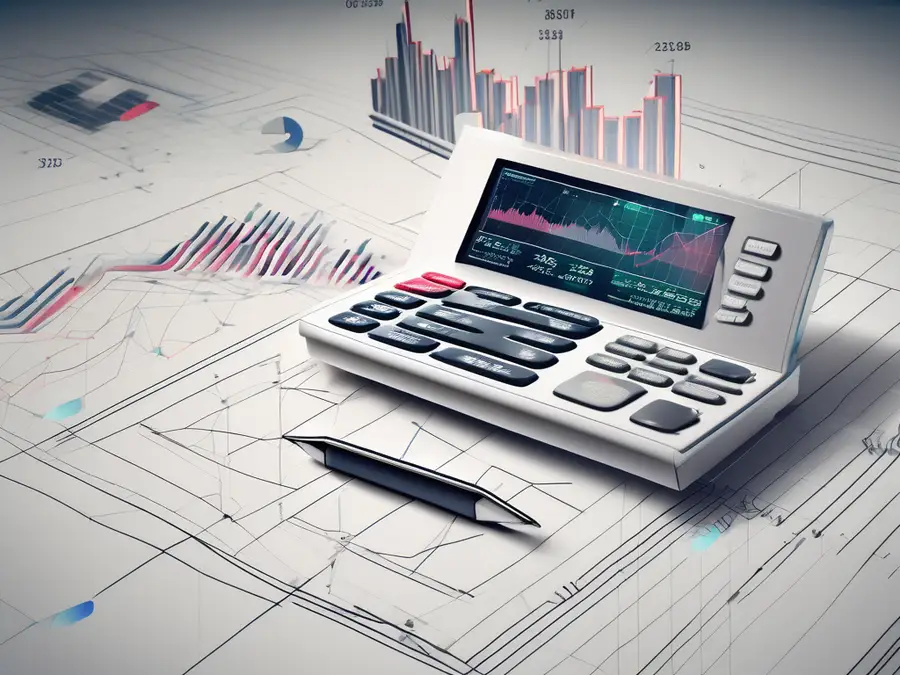All You Need to Know About Quantitative Trading

Quantitative trading has revolutionized the financial market, offering investors a systematic approach to making trading decisions based on mathematical models and data analysis. In this ultimate guide, I will provide you with a comprehensive overview of quantitative trading, including its definition, importance, and challenges. So let's dive right in!
Understanding Quantitative Trading
Definition and Basics of Quantitative Trading
Quantitative trading, also known as algorithmic trading or algo-trading, is a strategy that relies on mathematical models and computer algorithms to identify trading opportunities. It involves the use of statistical methods, data analysis, and complex algorithms to generate actionable insights and execute trades automatically.
By removing human emotions and biases from the equation, quantitative trading aims to enhance trading efficiency and improve overall returns. It allows traders to make data-driven decisions based on historical price patterns, market trends, and various other factors.
Quantitative trading systems can be categorized into different types, such as trend-following strategies, mean reversion strategies, and statistical arbitrage strategies. Each type focuses on exploiting different market inefficiencies and patterns to generate profits.
The Role of Quantitative Trading in the Financial Market
Quantitative trading plays a vital role in today's financial market ecosystem. It provides liquidity, enhances market efficiency, and reduces trading costs. With the help of advanced algorithms, quantitative traders can execute large volumes of trades within microseconds, ensuring efficient price discovery.
Moreover, quantitative trading contributes to the development of new trading strategies and risk management techniques. It allows traders to exploit market inefficiencies, arbitrage opportunities, and systematic trends that resonate with their trading models.
Quantitative trading also fosters innovation in financial markets by encouraging the use of cutting-edge technologies such as machine learning and artificial intelligence. These technologies enable traders to analyze vast amounts of data in real-time, identify patterns, and adapt their strategies swiftly to changing market conditions.
The Building Blocks of Quantitative Trading
Mathematical Models in Quantitative Trading
Mathematical models are the foundation of quantitative trading. These models utilize statistical techniques, stochastic processes, and mathematical equations to represent various market phenomena. By analyzing historical data and identifying recurring patterns, these models can predict future market behavior.
From simple moving averages to more complex models like support vector machines and neural networks, there's a wide range of mathematical models used in quantitative trading. Each model has its strengths and weaknesses, and successful traders often use a combination of models to increase accuracy and reliability.
Support vector machines (SVMs) are a type of supervised learning model that analyze data for classification and regression analysis. They are particularly useful in quantitative trading for identifying patterns in market data that may not be immediately apparent to human traders. Neural networks, inspired by the human brain's structure, can learn complex patterns in data and adapt to changing market conditions, making them valuable tools in quantitative trading strategies.
Importance of Data in Quantitative Trading
Data is at the heart of quantitative trading. Financial markets generate immense amounts of data every second, including price, volume, and news sentiment. Quantitative traders harness this data to gain insights into market dynamics and develop profitable trading strategies.
Historical data is used for backtesting, a crucial step in quantitative trading strategy development. By analyzing past market behavior and comparing it with their trading models, traders can evaluate the effectiveness and robustness of their strategies.
Real-time data feeds are also essential for quantitative traders to make informed decisions quickly. These feeds provide up-to-the-minute information on market movements, news events, and other factors that can impact trading strategies. By integrating real-time data into their models, traders can adapt to changing market conditions and seize profitable opportunities as they arise.
Developing a Quantitative Trading Strategy
Identifying a Trading Idea
Developing a successful quantitative trading strategy starts with a solid trading idea. Traders need to identify a market anomaly, inefficiency, or trend that their models can capitalize on. This could be anything from a correlation between two stocks or a pattern in a specific sector.
Backed by extensive research and domain knowledge, a trading idea provides the basis for building a mathematical model and designing the algorithmic trading strategy.
Furthermore, it's crucial for traders to stay updated with current market news, economic indicators, and geopolitical events that could impact their trading idea. Being aware of global events and their potential influence on financial markets can help traders anticipate market movements and adjust their strategies accordingly.
Backtesting the Strategy
Once a trading idea is established, it's essential to backtest the strategy using historical data. Backtesting involves simulating the performance of the trading strategy over a specified period, considering different market scenarios.
Backtesting helps traders assess the strategy's profitability, risk-adjusted returns, and drawdowns. It also allows for fine-tuning and optimization of parameter values to improve the strategy's performance.
Moreover, traders should consider conducting walk-forward testing after backtesting to validate the strategy's robustness. Walk-forward testing involves dividing the data into multiple segments, using each segment to optimize the strategy, and then testing it on subsequent data. This iterative process helps ensure that the strategy remains effective across different market conditions and time periods.
Risks and Challenges in Quantitative Trading
Overfitting in Quantitative Models
One of the common risks in quantitative trading is overfitting. Overfitting refers to the creation of a model that performs exceptionally well on the historical data used for developing it but fails to generalize to unseen data. It can lead to misleading results and unreliable predictions.
To mitigate the risk of overfitting, traders employ techniques like cross-validation, regularization, and robustness testing. These methods help ensure that the trading strategy remains robust and performs well on unseen market data.
Furthermore, overfitting can also occur when a model is overly complex, capturing noise in the data rather than true underlying patterns. Traders must strike a balance between model complexity and predictive power to avoid falling into the overfitting trap. By understanding the nuances of their data and the limitations of their models, traders can make more informed decisions and reduce the impact of overfitting on their trading strategies.
Dealing with Market Anomalies
Market anomalies, such as sudden price movements, short-term volatility, or unusual trading patterns, can pose challenges to quantitative traders. These anomalies may disrupt the normal functioning of trading models and lead to unexpected losses.
To navigate such situations, traders need to continuously monitor their strategies, adapt to changing market conditions, and incorporate risk management techniques. This flexibility is essential to withstand unexpected events and maintain stable performance.
In addition to monitoring market anomalies, traders can also leverage advanced technologies like machine learning and artificial intelligence to detect patterns and anomalies in real-time. By utilizing cutting-edge tools and algorithms, traders can enhance their decision-making process and stay ahead of market disruptions.
The Future of Quantitative Trading
Impact of Technology on Quantitative Trading
Technology advancements have played a crucial role in the evolution of quantitative trading. High-speed connectivity, cloud computing, and big data analytics have significantly enhanced the capabilities of quantitative trading systems.
New technologies like artificial intelligence (AI) and machine learning (ML) are gaining prominence in quantitative trading strategies. These technologies enable traders to analyze vast amounts of data, detect patterns, and make more accurate predictions, thereby increasing trading efficiency and profitability.
Quantitative Trading in the Era of AI and Machine Learning
The integration of AI and machine learning algorithms has the potential to revolutionize quantitative trading further. By leveraging deep learning models and reinforcement learning techniques, traders can develop adaptive trading systems that can continuously learn and adapt to changing market conditions.
However, it's important to note that sophisticated technology alone isn't enough. Successful quantitative trading still requires a deep understanding of finance, solid mathematical modeling skills, and continuous research and development to stay ahead in this competitive landscape.
As an expert in quantitative trading, I would like to share a personal advice. Keep learning and refining your trading strategies. The financial market is dynamic, and what works today may not work tomorrow. Continuously improve your models, embrace new technologies, and stay adaptable to seize opportunities and mitigate risks.
Frequently Asked Questions (FAQ)
What is quantitative trading?
Quantitative trading is a strategy that uses mathematical models and data analysis to make trading decisions. It relies on algorithms to identify trading opportunities based on historical price patterns, market trends, and various other factors.
Why is data important in quantitative trading?
Data is crucial in quantitative trading as it provides insights into market dynamics. Historical data is used for backtesting strategies, evaluating their effectiveness, and making informed trading decisions. Real-time data helps traders capitalize on market opportunities as they arise.
How do I develop a quantitative trading strategy?
To develop a quantitative trading strategy, start by identifying a trading idea or market anomaly that you can exploit. Then build a mathematical model based on this idea and backtest it using historical data. Continuously refine and optimize your strategy to improve performance.
What are the risks in quantitative trading?
Some of the risks in quantitative trading include overfitting, where the model performs well on historical data but fails to generalize to new data. Market anomalies can also pose challenges, as they may disrupt trading models and lead to unexpected losses. Risk management techniques are crucial for mitigating these risks.
What is the future of quantitative trading?
The future of quantitative trading lies in the integration of technologies like AI and machine learning. These advancements enable traders to analyze vast amounts of data, make more accurate predictions, and develop adaptive trading systems. However, a deep understanding of finance and continuous learning will remain essential for success.
I hope this comprehensive guide has provided valuable insights into the world of quantitative trading. Remember, success in quantitative trading requires expertise, a data-driven mindset, and adaptability. Stay informed, continue learning, and capitalize on the power of quantitative trading to achieve your investment goals.
Ready to take your quantitative trading to the next level with the latest technology and no fees? Look no further than Morpher, the revolutionary trading platform that leverages blockchain for an unparalleled trading experience. With Morpher, you can enjoy zero fees, infinite liquidity, and the ability to trade a vast array of assets—from stocks and cryptocurrencies to unique markets like NFTs and more. Whether you're looking to invest fractionally, short sell without interest fees, or maximize your trades with up to 10x leverage, Morpher offers the tools and safety you need to trade confidently and efficiently. Embrace the future of trading and Sign Up and Get Your Free Sign Up Bonus today to start your journey with Morpher.

Disclaimer: All investments involve risk, and the past performance of a security, industry, sector, market, financial product, trading strategy, or individual’s trading does not guarantee future results or returns. Investors are fully responsible for any investment decisions they make. Such decisions should be based solely on an evaluation of their financial circumstances, investment objectives, risk tolerance, and liquidity needs. This post does not constitute investment advice.

Painless trading for everyone
Hundreds of markets all in one place - Apple, Bitcoin, Gold, Watches, NFTs, Sneakers and so much more.

Painless trading for everyone
Hundreds of markets all in one place - Apple, Bitcoin, Gold, Watches, NFTs, Sneakers and so much more.









